Makhtesh Ramon
Makhtesh Ramon (Hebrew: מכתש רמון; lit. Ramon Crater/Makhtesh ; Arabic: وادي الرمان) is a geological feature of Israel's Negev desert. Located at the peak of Mount Negev, some 85 km south of the city of Beersheba, the landform is not an impact crater from a meteor nor a volcanic crater formed by a volcanic eruption, but rather is the world's largest "erosion cirque" (steephead valley or box canyons). The formation is 40 km long, 2–10 km wide and 500 meters deep, and is shaped like an elongated heart. The only settlement in the area is the small town of Mitzpe Ramon (מצפה רמון, "Ramon Lookout") located on the northern edge of the depression. Today the area forms Israel's largest national park, the Ramon Nature Reserve.
| Makhtesh Ramon | |
|---|---|
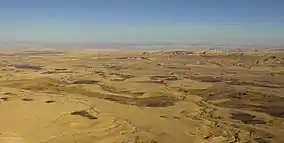 The "crater" is 40 km long, 2–10 km wide and 500 meters deep. | |
 Location of Maktesh Ramon | |
| Location | Southern, Israel |
| Coordinates | 30°34′43″N 34°49′4″E |
| Length | 40 km (25 mi) |
| Width | 2–10 km (1.2–6.2 mi) |

Formation
.jpg.webp)
Hundreds of millions of years ago, the Negev desert was covered by an ocean. Slowly, this started to recede northwards leaving behind a hump-shaped hill. The hump was slowly flattened by water and climatic forces. Approximately five million years ago, the Arava Rift Valley was formed, with rivers changing their courses, carving out the inside of the crater which was a softer rock than that overlying. The crater bottom continued to deepen at a much faster rate than the surrounding walls, which gradually increased in height. As the crater deepened, more layers of ancient rock were exposed with rocks at the bottom of the crater being up to 200 million years old. Today, the crater is 500 metres deep with the deepest point being Ein Saharonim (Saharonim Spring) which also contains the makhtesh's only natural water source, which sustains much of the wildlife in the makhtesh including onagers and ibex.
Geology
Makhtesh Ramon contains a diversity of rocks including clay hills known for their fantastic red and yellow colors and forms. Impressive mountains rise at the borders of the crater - Har Ramon (Mt. Ramon) at the southern end, Har Ardon (Mt. Ardon) at the north-eastern end, and two table mountains - Har Marpek (Mt. Marpek - "Elbow"), and Har Katum (Mt. Katum - "Cropped") along the southern wall. The hills to the north-eastern edge of the makhtesh were once entirely covered by spiral ammonite fossils, ranging from the size of snails to that of tractor wheels although these have mainly been extracted so only smaller fossils can be found here today.
Giv'at Ga'ash, a black hill in the north of the makhtesh was once an active volcano which erupted thousands of years ago and caused it to be covered in lava which quickly cooled in the open air, converting it into basalt. Limestone covered by basalt can also be found in smaller black hills in the southern part of the makhtesh, including Karnei Ramon.
Shen Ramon (Ramon's Tooth) is a rock made of magma which hardened whilst underground. It later rose up through cracks in the Earth's surface, and today stands in striking contrast with the nearby creamy coloured southern wall of the crater, as a black sharp-edged rock.
In the centre of the makhtesh is HaMinsara (The Carpentry Shop), a low hill made up of columnar jointed sandstone - polygonal prismatic columns of quartzite.
The pterioid bivalve Family Ramonalinidae is found in early Middle Triassic rocks of Makhtesh Ramon and was named after this feature.
Nahal Ardon in the east of the makhtesh contains several vertical dikes. Occasional geodes of celestine can be found next to some of them.[1]
Fauna
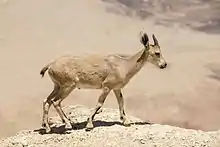
The Asian wild ass has been reintroduced to Makhtesh Ramon. In 1995 the population had increased to 40 adults in the area. The animals are hybrids of two different subspecies of the Asian Wild Ass. It is derived from the Turkmenian kulan (E. h. kulan) and the Persian onager (E. h. onager). The original subspecies, the Syrian wild ass (E. h. hemippus), is completely extinct.[2] Other larger mammals of the area include Nubian ibexes, Dorcas gazelles, striped hyenas and few Arabian leopards.
History
The ruins of a large prehistoric stone structure known as Khan Saharonim are found in the makhtesh, as it lies along the ancient Incense Route, a trade route used by the Nabataeans 2,000 years ago. These ruins acted as a way station for the traders and their animals (khan is the Arabic word for a caravanserai) as they proceeded further westwards to the Mediterranean seaport city of Gaza.
Gallery
.jpg.webp) View of Makhtesh Ramon from its west
View of Makhtesh Ramon from its west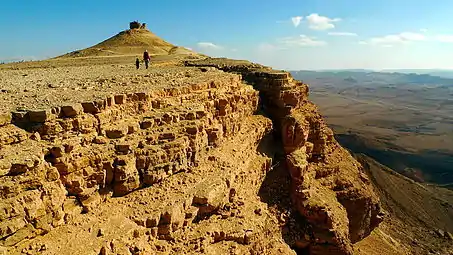 The cliff
The cliff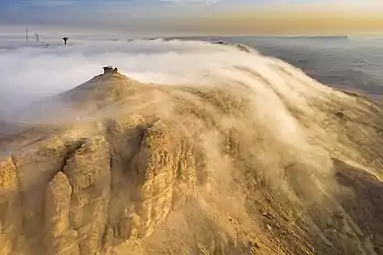 Cloud gliding (advection fog) in Makhtesh Ramon
Cloud gliding (advection fog) in Makhtesh Ramon%252C_at_the_north_edge_of_Ramon_crater_(Makhtesh_Ramon)%252C_Negev%252C_Israel.jpg.webp) Dry Drimia maritima (Urginea maritima) at the northern edge of the makhtesh
Dry Drimia maritima (Urginea maritima) at the northern edge of the makhtesh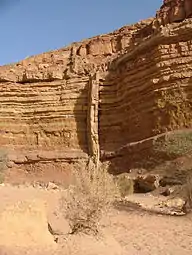 Rock formation (dike)
Rock formation (dike)_in_Makhtesh_Ramon%252C_Negev%252C_Israel.jpg.webp) Ha-Minsara (The Sawmill)
Ha-Minsara (The Sawmill)%252C_Israel.jpg.webp) Sandy rectangular and hexagonal prisms at the centre of Makhtesh Ramon – Ha-Minsara (The Sawmill)
Sandy rectangular and hexagonal prisms at the centre of Makhtesh Ramon – Ha-Minsara (The Sawmill)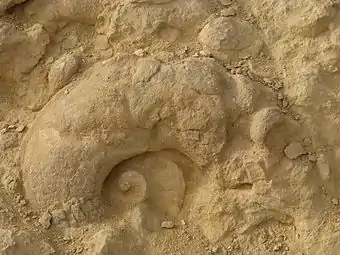 An ammonite in the Ammonite Wall
An ammonite in the Ammonite Wall Ammonite Wall (Tamar Formation, Cenomanian)
Ammonite Wall (Tamar Formation, Cenomanian)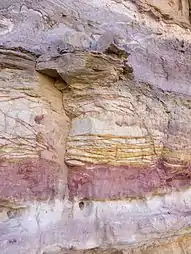 Sandstone color bands
Sandstone color bands
References
- Michael Anenburg; Or M. Bialik; Yevgeny Vapnik; Hazel J. Chapman; Gilad Antler; Yaron Katzir; Mike J. Bickle (2014). "The origin of celestine–quartz–calcite geodes associated with a basaltic dyke, Makhtesh Ramon, Israel". Geological Magazine. 151 (5): 798–815. Bibcode:2014GeoM..151..798A. doi:10.1017/S0016756813000800.
- David Saltz David, Mary Rowen, Daniel I. Rubenstein: The Effect of Space-Use Patterns of Reintroduced Asiatic Wild Ass on Effective Population Size. Conservation Biology, Vol. 14, No. 6, 2000
- Mazor, Emanuel and Krasnov, Boris, editors "The Makhteshim Country - a Laboratory of Nature". Pensoft Publishers, Sofia, 2001, ISBN 954-642-135-9, 411 pages
External links
| Wikimedia Commons has media related to Makhtesh Ramon. |
- Ramon Crater on Google Maps
- Ramon Crater Detailed trail and hiking info. from Tourism, trips and travel in Israel
- Makhtesh Ramon's Visitors Center, at the Israel Nature and Parks Authority's website.
- Bird's eye view of Ramon Crater
